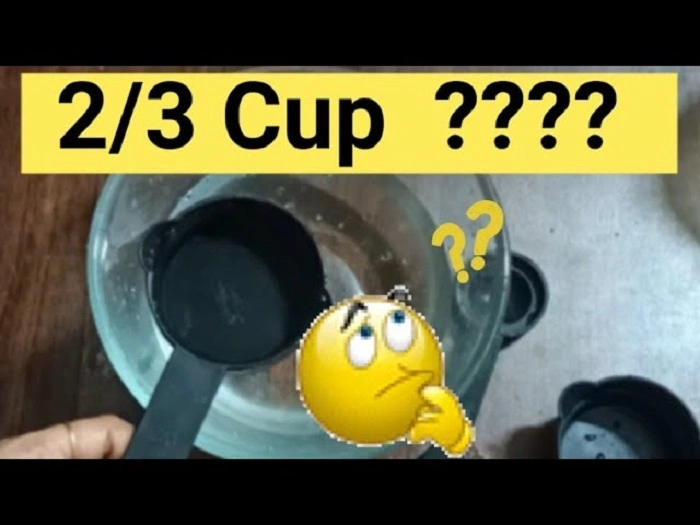If you’ve ever found yourself in the kitchen staring at a recipe that calls for 2/3 cup, you’re not alone. It’s one of those measurements that’s not always available on your standard set of measuring cups—and it can cause unnecessary confusion when you’re trying to whip up a recipe quickly.
Whether you need to convert 2/3 cup into tablespoons, milliliters, or smaller cup fractions, this guide will help you measure it out with ease.
Knowing a few quick equivalents and tricks can help you stay precise, even if you don’t have a 2/3 cup measure handy.
Table of Contents
Quick Answer: 2/3 Cup = 10 tablespoons + 2 teaspoons
That’s right—if your measuring cup set jumps from 1/2 cup to 3/4 cup (and skips 2/3), here’s what you do:
- 2/3 cup = 10 tablespoons + 2 teaspoons
This conversion works for both dry and liquid ingredients (by volume), and it’s especially useful when baking, where accuracy matters most.
Other Equivalents:
| Unit | Amount in 2/3 Cup |
| Tablespoons | 10 tbsp + 2 tsp |
| Milliliters (ml) | ~158 ml |
| Fluid ounces (U.S.) | ~5.3 fl oz |
| Teaspoons | 32 tsp |
Having this conversion in your back pocket means you’ll never be held up by this pesky measurement again.
How to Measure 2/3 Cup Without a 2/3 Cup

Most measuring cup sets include 1 cup, 1/2 cup, 1/3 cup, and 1/4 cup—but not always a 2/3. If yours doesn’t, you can combine other measures:
Option 1: Use 1/3 cup twice
- 1/3 cup + 1/3 cup = 2/3 cup
This is the simplest and most accurate method if you have a 1/3 cup measure.
Option 2: Use tablespoons and teaspoons
- Measure 10 tablespoons + 2 teaspoons
- Level each spoon for accuracy
Option 3: Use milliliters
- 2/3 cup = 158 ml
- Use a liquid measuring cup with milliliter markings
Common Ingredients Measured in 2/3 Cup
Some recipes specifically call for 2/3 cup of certain ingredients. Here’s how that translates:
| Ingredient | Weight (approx.) |
| Granulated sugar | ~134 grams |
| Brown sugar (packed) | ~142 grams |
| All-purpose flour | ~85 grams |
| Butter | ~152 grams (or 10 tbsp + 2 tsp) |
| Milk | ~158 ml |
| Oil (vegetable, olive) | ~158 ml |
These values can vary depending on how ingredients are scooped, packed, or sifted—especially for dry items like flour and sugar.
Converting 2/3 Cup to Other Cup Fractions
Want to scale your recipe up or down? Here’s how 2/3 cup breaks down:
| Fraction of a Cup | Equals in Cups |
| 1/3 cup | Half of 2/3 cup |
| 1/6 cup | One-third of 2/3 cup |
| 4/3 cup (or 1 1/3 cup) | Double 2/3 cup |
| 1 cup | More than 2/3 cup by 1/3 cup |
This helps when doubling or halving recipes with odd measurements.
Why 2/3 Cup Matters in Recipes
You might wonder—why not just round up to 3/4 or down to 1/2?
In baking, even slight measurement changes can affect:
- Texture: Too much flour or too little liquid = dry results
- Flavor balance: Especially with sugar, spices, or vinegar
- Structure: Leavening reactions depend on precise ratios
So if your recipe calls for 2/3 cup, it’s best to measure it accurately rather than estimate.
Tips for Accurate Measuring
- Use dry measuring cups for flour, sugar, oats, etc.
- Use liquid measuring cups for milk, oil, or broth
- Level off dry ingredients with a knife for exact amounts
- Spoon and level flour instead of scooping directly from the bag
- Warm sticky ingredients (like honey or syrup) slightly to help them pour
These small steps make a big difference in your final dish.
FAQs About 2/3 Cup
How many grams is 2/3 cup of flour?
Approximately 85 grams, but it varies slightly depending on the brand and how it’s measured.
Is 2/3 cup more than half a cup?
Yes! 1/2 cup = 8 tbsp, while 2/3 cup = 10 tbsp + 2 tsp.
Can I estimate 2/3 cup without measuring?
In a pinch, yes. Fill a 1-cup measure about two-thirds full, or use 1/3 cup twice. But for baking, it’s best to measure properly.
Can I use 3/4 cup instead of 2/3?
3/4 cup is slightly more than 2/3 cup. For most cooking, it’s okay—but not ideal for baking.
Why don’t measuring sets include 2/3 cup?
Most standard sets include only the most common fractions. You can always use two 1/3 cups to make 2/3.
Knowing how to measure 2/3 cup without guessing can make your kitchen experience smoother and more accurate. Whether you’re baking, cooking, or doubling recipes, these simple conversions will keep you on track.
Next time you’re stuck with a recipe that calls for 2/3 cup, just remember: 10 tablespoons + 2 teaspoons, or 1/3 cup twice—and you’re good to go.

